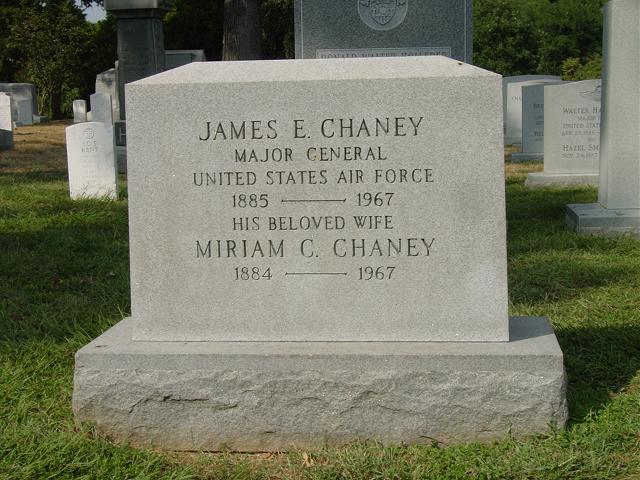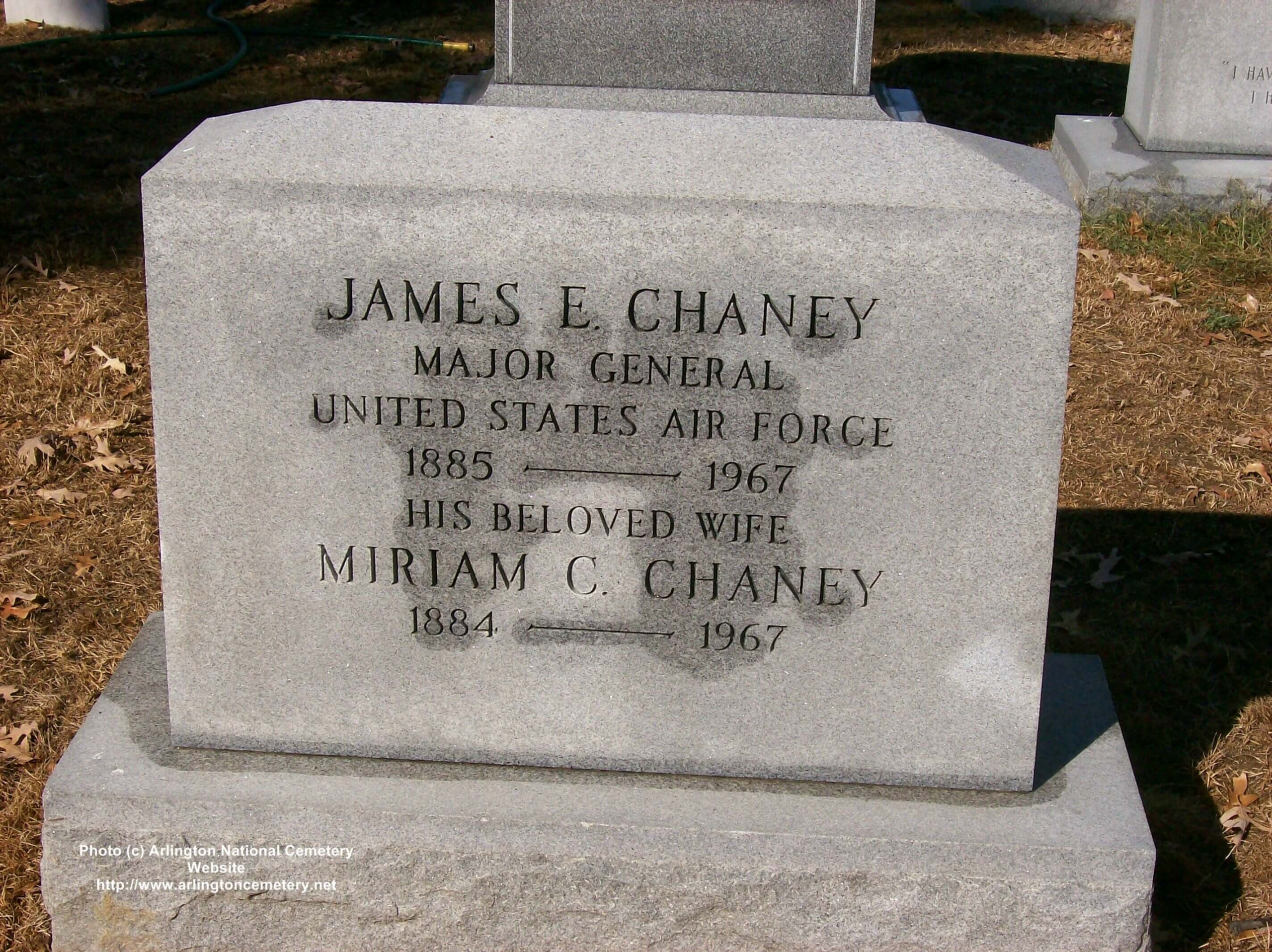Courtesy of the United States Air Force
MAJOR GENERAL JAMES E. CHANEY
Died September 1, 1967
James Eugene Chaney was born at Chaney, Maryland, in 1885, the son of Dr. Thomas W. Chaney. He attended Baltimore City College for three years and was appointed to the U.S. Military Academy, West Point, New York, June 16, 1904. Upon graduation Feb. 14, 1908, he was appointed a Second Lieutenant of Infantry.
EFFECTIVE DATES OF PROMOTION
He was promoted to First Lieutenant June 20, 1914; to Captain March 22, 1917; to Major (temporary) August 5, 1917; to Lieutenant Colonel (temporary) April 7, 1919. He reverted to his permanent rank of Captain June 30, 1920; was promoted to Major, Regular Army, July 1, 1920; to Lieutenant Colonel February 1, 1932. On July 17, 1934 he was appointed Assistant Chief of Air Corps, with the temporary rank of Brigadier General. Upon completion of that tour of duty July 16, 1938, he reverted to his permanent rank of Colonel, to which he had been promoted December 24, 1936. On January 1, 1940 he was promoted to Brigadier General, and October 1, 1940 to major general (temporary).
SERVICE
He first served with the 9th Infantry at Fort Sam Houston, Texas to February 1910; then was on detached service in Europe, Africa and Asia to July 1910. He next served with his regiment at Iloilo, Philippine Islands, to June 1912, and upon his return to the U.S., he became instructor in modern languages at the U.S. Military Academy, West Point, New York, until July 1914. In September 1914, he joined the 30th Infantry at the Presidio of San Francisco, California, remaining there until December of the same year, when he was ordered to Hawaii.
He served with the 25th Infantry at Schofield Barracks, Hawaii to September 1917, when he was detailed in the Air Service and returned to the U.S. He was stationed at Chanute Field, Illinois, until November 1917; became commandant of the School of Military Aeronautics, Columbus, Ohio to June 1918; and executive officer, Operations Section, Office of the Director of Military Aeronautics, Washington, D.C. to August 1918.
He sailed for Europe in August 1918, where he served at Air Service Headquarters Service of Supplies, to September 1918; with the Coordination Staff, Headquarters of the Chief of Air Service, American Expeditionary Forces, to October 1918; and in the Office of the Chief of Air Service and executive officer, Office of the Assistant Chief of Staff, Air Service, American Expeditionary Forces to February 1919. He commanded the airdrome at Cablenz, Germany to April 1919 and served in the Office of the Air Service Commander, Third Army, at Coblenz, Germany to June 1919. He then commanded the Air Service Production Center at Romerantin, France to August 1919 and was U.S. aviation officer, Provisional District of Great Britain to October 1919.
He was appointed assistant military attach for aviation at Rome, Italy in October 1919, where he served until June 1924. He returned to the U.S. in the summer of 1924, and was assigned to duty at Langley Field, Virginia, to October 1924. He attended the Command and General Staff School at Fort Leavenworth, Kansas, completing the course as an honor graduate in June 1926. He was commandant of the Air Corps Primary Flying School, Brooks Field, to March 1928, and commandant of the Air Corps Advanced Flying School, Kelly Field, Texas, to June 1930.
He then attended the Army War College in Washington, D.C. to June 1931, and after graduation was assigned to duty in the Office of the Chief of Air Corps in Washington, D.C., until January 1932. He next served as technical adviser on aviation matters to General George S. Simonds at the Disarmament Conference at Geneva, Switzerland to June 1932. When he returned to the U.S., he resumed his duties in the Office of the Chief of the Air Corps, Washington, D.C., where he served until April 1935, during which period he was made assistant chief of the Air Corps.
In May 1935, he took command of the Air Corps Training Center at Randolph Field, Texas, in which capacity he served until completion of his tour as assistant chief of Air Corps in July 1938. He was then ordered to Mitchel Field, New York, where in January 1940, he was made head of the Air Defense Command. In October 1940, he was assigned additionally as commanding general of the Northeast Air District, with Headquarters at Mitchel Field, New York, later called the First Air Force. In October-November 1940, he was in England as observer during part of the Battle of Britain and the bombing of London. In May 1941, he was assigned to the United Kingdom, with station at London, England, as special Army observer and head of the Special Army Observers Group there. From January 1942 to June 1942, he was the commanding general, U.S. Army Forces in the British Isles.
He was assigned, in July 1942 as commanding general of the First Air Force, with Headquarters at Mitchel Field, N.Y. From May 1942 to November 1944, he commanded the Army Air Forces Basic Training Center at Sheppard Field, Texas, and then the Air Forces Western Technical Training Command with Headquarters in Denver, Colorado. From November 1944 to July 1945, he commanded Army forces in the preparation, the seizure, occupation and development of Iwo Jima. From March of 1945, as island commander, he commanded all U.S. forces on Iwo Jima (Army, Navy, Air Forces and Marines). In August of 1945, he was named as commanding general of the Western Pacific Base Command, with Headquarters on Saipan. In October 1945, he was assigned as member and later as president, Secretary of War’s Personnel Board, Washington, D.C.
Iwo Jima in the Western Pacific, about 700 miles south of Tokyo, spearheaded the American drive on Japan proper. It formed a base for bomber and fighter operations against Japan proper, and a refuge for many battle-damaged B-29’s operating against Japan from the Marianas.
He is rated a military command pilot, combat observer, and technical observer.
DECORATIONS
He was awarded the Distinguished Service Medal in 1943, with the following citation.
“For exceptionally meritorious service in a position of great responsibility. As special Army observer, and head of the Special Army Observers Group, London, England, from May 19421 to June 20, 1942, and as theater commander between the dates Jan. 8 to June 20, 1942, General Chaney rendered service of outstanding value and importance, both individually and in guiding and directing the labors of the group, in establishing coordination and contact with the British Army, Air Force, Navy, and other governmental departments and agencies; in the planning for the reception of the U.S. Army forces in Iceland, Northern Ireland and Great Britain; and in the establishment of the European Theater of Operations. Working with limited means and often under trying conditions, he performed his missions with inspiring leadership and unswerving devotion to duty. His personality and his labors were outstanding factors in the success of the mission, and the establishment of the European theater which he commanded.”
In addition, he has received the following awards.
- Distinguished Service Medal
- Legion of Merit
- oak leaf cluster to Legion of Merit
- Commander, Southern Cross
- Officer, Crown of Italy
- War Cross, Italian
- War Zone Medal, Italian, World War I
- Officer, Prince Danilo, World War I
- Army of Occupation of Germany, World War I
- Victory Medal, World War I, with two battle stars
- American Defense Ribbon with star
- European Theater Ribbon
- North American Theater Ribbon, outside U.S.A.
- Asiatic-Pacific Ribbon, with arrowhead and star
- Victory Medal, World War II
CHANEY, JAMES E
- MG USAF
- DATE OF BIRTH: 03/16/1885
- DATE OF DEATH: 08/21/1967
- BURIED AT: SECTION 1 SITE 168-C
- ARLINGTON NATIONAL CEMETERY
CHANEY, MARIAN CLARK W/O JAMES E
- DATE OF BIRTH: 03/01/1884
- DATE OF DEATH: 11/20/1967
- BURIED AT: SECTION 1 SITE 168-C
- ARLINGTON NATIONAL CEMETERY
Michael Robert Patterson was born in Arlington and is the son of a former officer of the US Army. So it was no wonder that sooner or later his interests drew him to American history and especially to American military history. Many of his articles can be found on renowned portals like the New York Times, Washingtonpost or Wikipedia.
Reviewed by: Michael Howard


